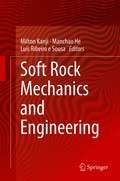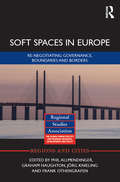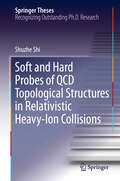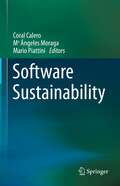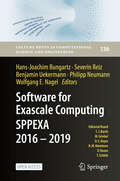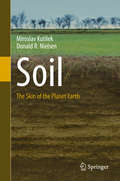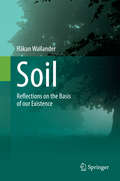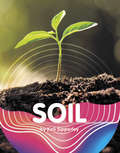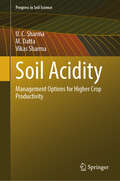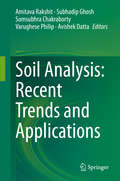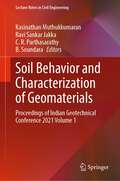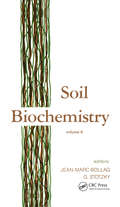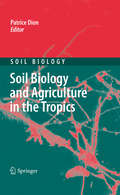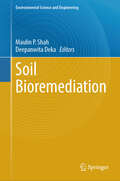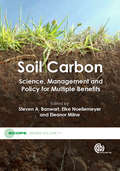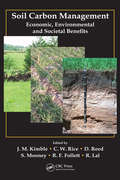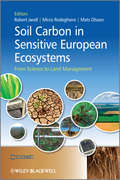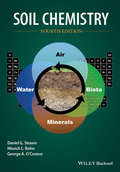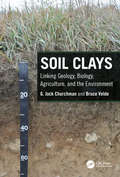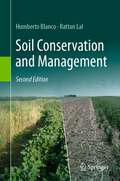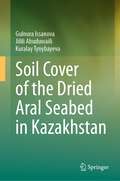- Table View
- List View
Soft Rock Mechanics and Engineering
by Milton Kanji Manchao He Luís Ribeiro e SousaThis book offers a practical reference guide to soft rock mechanics for engineers and scientists. Written by recognized experts, it will benefit professionals, contractors, academics, researchers and students working on rock engineering projects in the fields of civil engineering, mining and construction engineering. Soft Rock Mechanics and Engineering covers a specific subject of great relevance in Rock Mechanics – and one that is directly connected to the design of geotechnical structures under difficult ground conditions. The book addresses practical issues related to the geomechanical properties of these types of rock masses and their characterization, while also discussing advances regarding in situ investigation, safety, and monitoring of geotechnical structures in soft rocks. Lastly, it presents important case histories involving tunnelling, dam foundations, coal and open pit mines and landslides.
Soft Spaces in Europe: Re-negotiating governance, boundaries and borders (Regions and Cities)
by Jörg Knieling Graham Haughton Frank Othengrafen Phil AllmendingerThe past thirty years have seen a proliferation of new forms of territorial governance that have come to co-exist with, and complement, formal territorial spaces of government. These governance experiments have resulted in the creation of soft spaces, new geographies with blurred boundaries that eschew existing political-territorial boundaries of elected tiers of government. The emergence of new, non-statutory or informal spaces can be found at multiple levels across Europe, in a variety of circumstances, and with diverse aims and rationales. This book moves beyond theory to examine the practice of soft spaces. It employs an empirical approach to better understand the various practices and rationalities of soft spaces and how they manifest themselves in different planning contexts. By looking at the effects of new forms of spatial governance and the role of spatial planning in North-western Europe, this book analyses discursive changes in planning policies in selected metropolitan areas and cross-border regions. The result is an exploration of how these processes influence the emergence of soft spaces, governance arrangements and the role of statutory planning in different contexts. This book provides a deeper understanding of space and place, territorial governance and network governance.
Soft and Hard Probes of QCD Topological Structures in Relativistic Heavy-Ion Collisions (Springer Theses)
by Shuzhe ShiThis thesis makes significant advances in the quantitative understanding of two intrinsically linked yet technically very different phenomena in quantum chromodynamics (QCD). Firstly, the thesis investigates the soft probe of strong interaction topological fluctuations in the quark-gluon plasma (QGP) which is made possible via the anomalous chiral transport effects induced by such fluctuations. Here, the author makes contributions towards establishing the first comprehensive tool for quantitative prediction of the chiral magnetic effect in the QGP that is produced in heavy ion collision experiments. Secondly, the thesis deals with the hard probe of strongly coupled QGP created in heavy-ion collisions. In particular, this study addresses the basic question related to the nonperturbative color structure in the QGP via jet energy loss observables. The author further develops the CUJET computational model for jet quenching and uses it to analyze the topological degrees of freedom in quark-gluon plasma. The contributions this thesis makes towards these highly-challenging problems have already generated widespread impacts in the field of quark-gluon plasma and high-energy nuclear collisions.
Software Sustainability
by Coral Calero Mario Piattini Mª Ángeles MoragaThis book focuses on software sustainability, regarded in terms of how software is or can be developed while taking into consideration environmental, social, and economic dimensions. The sixteen chapters cover various related issues ranging from technical aspects like energy-efficient programming techniques, formal proposals related to energy efficiency measurement, patterns to build energy-efficient software, the role of developers on energy efficient software systems and tools for detecting and refactoring code smells/energy bugs; to human aspects like its impact on software sustainability or the adaptation of ACM/IEEE guidelines for student and professional education and; and an economics-driven architectural evaluation for sustainability. Also aspects as the elements of governance and management that organizations should consider when implementing, assessing and improving Green IT or the relationship between software sustainability and the Corporate Social Responsibility of software companies are included. The chapters are complemented by usage scenarios and experience reports on several domains as cloud applications, agile development or e-Health, among others. As a whole, the chapters provide a complete overview of the various issues related to sustainable software development. The target readership for this book includes CxOs, (e.g. Chief Information Officers, Chief Executive Officers, Chief Technology Officers, etc.) software developers, software managers, auditors, business owners, and quality professionals. It is also intended for students of software engineering and information systems, and software researchers who want to know the state of the art regarding software sustainability.
Software for Exascale Computing - SPPEXA 2016-2019 (Lecture Notes in Computational Science and Engineering #136)
by Hans-Joachim Bungartz Wolfgang E. Nagel Philipp Neumann Severin Reiz Benjamin UekermannThis open access book summarizes the research done and results obtained in the second funding phase of the Priority Program 1648 "Software for Exascale Computing" (SPPEXA) of the German Research Foundation (DFG) presented at the SPPEXA Symposium in Dresden during October 21-23, 2019. In that respect, it both represents a continuation of Vol. 113 in Springer’s series Lecture Notes in Computational Science and Engineering, the corresponding report of SPPEXA’s first funding phase, and provides an overview of SPPEXA’s contributions towards exascale computing in today's sumpercomputer technology. The individual chapters address one or more of the research directions (1) computational algorithms, (2) system software, (3) application software, (4) data management and exploration, (5) programming, and (6) software tools. The book has an interdisciplinary appeal: scholars from computational sub-fields in computer science, mathematics, physics, or engineering will find it of particular interest.
Soil
by Miroslav Kutílek Donald R. NielsenThe main focus of this monograph is to explain the important role of soil and the environment to a broad audience. Soil is one of the five essential factors crucial for human life. On the one hand the authors describe a responsible approach and use of soil, established on a basic knowledge of the nature of soil and the countless ongoing processes within soil. On the other hand they explain the precarious link between soil and regional environment, which is indispensable for plant and animal communities. In addition to these topics its chapters describe the unique roles of soil texture, soil structure and soil pore systems in hydrologic cycles, plant nutrition and conditions affecting the preservation or eventual extinction of soil. This book concludes with the principles of soil protection and revitalization. General readers with an interest in biology, chemistry, physics or geology will find this book highly informative.
Soil
by Håkan WallanderHåkan Wallander is a professor in Soil Biology and the reader is guided through the fascinating world below ground. The book has a free form and the author mixes scientific facts with personal stories from active research experiences and everyday life. The main focus is to make the reader aware of the vast biodiversity that exists in the soil, and to describe the important processes provided by the soil organisms. Reflections are made on how dependent we are on living soils, and how vulnerable the soil is if managed in a wrong way. The importance of soils as carbon sinks and reflections about the possible influence of soils for taste and quality of food and wine is also covered. The book is illustrated with photographs and every picture has a legend that stands on its own. In this way the reader will have an easy way into the book, and the main aim is to gain new readers to a subject that is immensely important, but not very attractive to laypersons.
Soil (Earth Materials and Systems)
by Keli SipperleySoil covers most of the land on Earth. It feeds plants and is home to many animals. Discover why soil is an important part of nature!
Soil (Rocks and Minerals)
by Melissa StewartHave you ever wondered how soil is different from dirt, or where soil comes from? Do you know the different animals and organisms that live in soil? What are the many ways that we use soil? Read Soil to find the answers to these questions and many more. You'll also find a hands-on activity to try at home or at school, as well as a glossary of unfamiliar words, resources to help you locate additional information, and a useful index.
Soil Acidity: Management Options for Higher Crop Productivity (Progress in Soil Science)
by Vikas Sharma U. C. Sharma M. DattaThe book on acid soils offers a thorough analysis of the degree of soil acidity at the global level, information on the biota, chemistry, and behaviour of acid soils, as well as the mechanisms by which plants tolerate soil acidity. It also offers crop management strategies that make effective use of amendments and acid soil-specific crop management practices. Crop output, forest health, and aquatic life all suffer from acidic soil. The main causes are the toxicity of aluminium (Al) and/or manganese (Mn), as well as the deficiencies of calcium (Ca), magnesium (Mg), phosphorus (P), and molybdenum (Mo), to a lesser extent. Lack of calcium affects the health and integrity of cells, which lowers agricultural yield and quality. To achieve the highest crop productivity, management options have been provided. All concerned will find this book of great assistance in solving the global food crisis in a sustainable manner.
Soil Analysis: Recent Trends and Applications
by Amitava Rakshit Subhadip Ghosh Somsubhra Chakraborty Varughese Philip Avishek DattaSoil analysis is critically important in the management of soil-based production systems. In the absence of efficient methods of soil analysis our understanding of soil is pure guesswork. Ideally the pro-active use of laboratory analysis leads to more sustainable soil productivity. Unfortunately, most of the world’s agriculture is still reactionary, waiting for obvious yield declines to occur before taking action to identify the reasons. The modern soil laboratory is pivotal to informing soil managers what adaptive practices are needed to address chemical and physical imbalances before they occur, and the intelligent adaptive use of laboratory data not only greatly speeds up and reduces the cost of empirical soil study, but can even render it unnecessary. This book provides a synopsis of the analytical procedures used for soil analysis, discussing the common physical, chemical and biological analytical methods used in agriculture and horticulture. Written by experienced experts from institutions and laboratories around the globe, it provides insights for a range of users, including those with limited laboratory facilities, and helps students, teachers, soil scientists and laboratory technicians increase their knowledge and skills and select appropriate methods for soil analysis.
Soil Behavior and Characterization of Geomaterials: Proceedings of Indian Geotechnical Conference 2021 Volume 1 (Lecture Notes in Civil Engineering #296)
by C. R. Parthasarathy Kasinathan Muthukkumaran Ravi Sankar Jakka B. SoundaraThis book comprises the select peer-reviewed proceedings of the Indian Geotechnical Conference (IGC) 2021. The contents focus on Geotechnics for Infrastructure Development and Innovative Applications. The book covers topics related to soil behavior and characterization of geomaterials, geotechnical, geological, and geophysical investigation of special topics such as behavior of unsaturated soils, offshore and marine geotechnics, remote sensing and GIS, instrumentation and monitoring, retrofitting of geotechnical structures, reliability in geotechnical engineering, geotechnical education, codes and standards, among others. This volume will be of interest to those in academia and industry.
Soil Biochemistry: Volume 8
by Jean-Marc Bollag G. StotzkyStressing the potential application of biochemical processes in soil to environmental biotechnology, this state-of-the-art reference considers the vital role that such biochemical processes have in the environment - emphasizing the activity of micro-organisms in soil.;An up-to-date analysis of biological reactions in soil, Volume 8 of Soil Biochemistry highlights: traditional as well as molecular and immunlogical techniques for detecting specific micro-organisms in soil; the fate of introduced genetically-modified organisms; the problem of competition by the indigenous microbial populations with the introduced organisms; the use of a white rot fungus, Phanerochaete chrysosporium, for bioremediative purposes in soil; the interaction of xenobiotics, such as pesticides, with soil organisms; generic microbial metabolism and degradation pathways; the inhibition of the nitrification process by allelochemicals released by plants; the microbial mineralization of various compounds under anaerobic conditions, explaining its importance in the global carbon cycle; the formation of soil organic matter, particularly in forest soils; and CPMAS 13C-NMR spectroscopy, a major analytical technique to determine the chemicals or chemical groups involved in the humification process.;Presenting a multidisciplinary approach to the field by internationally acclaimed scientists, Soil Biochemistry, Volume 8 is intended for professionals and students in the fields of soil science; microbiology; biochemistry; environmental science, engineering and technology; biogeochemistry; biotechnology; agronomy; plant pathology; and microbial ecology.
Soil Biology and Agriculture in the Tropics
by Patrice DionThe relationships between soils, microbes and humans are of crucial relevance in the tropics, where plant stress and microbial activity are exacerbated. This volume of Soil Biology presents the living component of tropical soils, showing how it is shaped by environmental conditions and emphasizing its dramatic impact on human survival and well-being. Following an introduction to the specificities of tropical soils and of their microbial communities, the biological aspects of soil management are examined, dealing with land use change, conservation and slash-and-burn agriculture, the restoration of hot deserts, agroforestry and paddy rice cultivation. As they are of particular relevance for tropical agriculture, symbioses of plants and microbes are thoroughly covered, as are the biodegradation of pesticides and health risks associated with wastewater irrigation. Lastly, traditional soil knowledge is discussed as a key to our sustainable presence in this world.
Soil Bioremediation (Environmental Science and Engineering)
by Maulin P. Shah Deepanwita DekaThis book is presented on bioremediation of soil including different aspects for sustainable development of agriculture, environment etc. Significant attention is being paid to plants and microbes because of their metabolomics, molecular mechanisms, biochemical pathways, bioengineering, and cost-effective nature in an eco-friendly green approach. It presents a detailed account on phytoremediation, microbial remediation; application of different plants and microorganisms for bioremediation in agricultural soil; nanoparticles, metabolites produced by plants and microbes for bioremediation of soil; multidisciplinary approaches of bioremediation to alleviate major soil contamination issues, molecular mechanisms, biochemical approach of bioremediation of soil; plants and microbial engineering for bioremediation; recent advances and challenges; future prospects of bioremediation of contaminated soil, utilizing biodiversity for sustainable development of the soil ecosystem.
Soil Carbon
by Meine Van Noordwijk Pete Smith Christiano Ballabio Daniel Buschiazzo Elke Noellemeyer Steven A Banwart Bas Van Wesemael Genxing Pan Francesca Bampa Rich Conant Heitor L.C. Coutinho Patrick Gicheru Andre Bationo Roger Funk David Werner Martial Bernoux Unai Pascual Tapas Bhattacharyya Marty Goldhaber Hans Joosten Dave Abson Niels Batjes Carlos Eduardo Cerri Generose Nziguheba David Powlson Christian Feller Pierre-Alain Maron Luca Montanarella Yongcun Zhao Chris Duffy Eleanor MilneThis book brings together the essential evidence and policy opportunities regarding the global importance of soil carbon for sustaining Earth's life support system for humanity. Covering the science and policy background for this important natural resource, it describes land management options that improve soil carbon status and therefore increase the benefits that humans derive from the environment. Written by renowned global experts, it is the principal output from a SCOPE rapid assessment process project. Read a chapter for free
Soil Carbon Dynamics
by Werner L. Kutsch Michael Bahn Andreas HeinemeyerCarbon stored in soils represents the largest terrestrial carbon pool and factors affecting this will be vital in the understanding of future atmospheric CO2 concentrations. This book provides an integrated view on measuring and modeling soil carbon dynamics. Based on a broad range of in-depth contributions by leading scientists it gives an overview of current research concepts, developments and outlooks and introduces cutting-edge methodologies, ranging from questions of appropriate measurement design to the potential application of stable isotopes and molecular tools. It includes a standardised soil CO2 efflux protocol, aimed at data consistency and inter-site comparability and thus underpins a regional and global understanding of soil carbon dynamics. This book provides an important reference work for students and scientists interested in many aspects of soil ecology and biogeochemical cycles, policy makers, carbon traders and others concerned with the global carbon cycle.
Soil Carbon Management: Economic, Environmental and Societal Benefits
by R. Lal J. M. Kimble C. W. Rice D. Reed S. Mooney R. F. FollettBetter Manage Soil C for Improved Soil Quality In the United States, soil has fueled the availability of abundant, safe food, thus underpinning economic growth and development. In the future we need to be more vigilant in managing and renewing this precious resource by replacing the nutrients and life-sustaining matter that we remove for
Soil Carbon in Sensitive European Ecosystems
by Mats Olsson Robert Jandl Mirco RodeghieroSoil Carbon in Sensitive European Ecosystems - From Science to Land Management is a comprehensive overview of the latest research in this field drawn together by a network of scientists from across Europe. Soil carbon assessments are crucial at present to our understanding of the dynamics of terrestrial ecosystems and our ability to assess implications for the global carbon exchange and its consequences on the future climate. This book focuses primarily on ecosystems and their soil carbon stocks. The book identifies three key sensitive ecosystems within Europe: Mediterranean Forest and Agricultural Systems; Mountains; and Peatland.Contributors include those currently working for the European research programme, COST Action 639 BurnOut (www.cost639.net; 2006-2010).COST Action 639 emerged from a demand from policy makers in Europe for more detailed information on soil carbon dynamics. The cooperation between experts for reporting and experts for soil dynamics is the focus of the book. This book seeks to provide an up-to-date account on the state-of-the-art research within this topical field.
Soil Carbon: Science, Management and Policy for Multiple Benefits
by Meine Van Noordwijk Pete Smith Christiano Ballabio Daniel Buschiazzo Bas Van Wesemael Genxing Pan Francesca Bampa Rich Conant Heitor L.C. Coutinho Patrick Gicheru Andre Bationo Roger Funk David Werner Martial Bernoux Unai Pascual Tapas Bhattacharyya Marty Goldhaber Hans Joosten Dave Abson Niels Batjes Carlos Eduardo Cerri Generose Nziguheba David Powlson Christian Feller Pierre-Alain Maron Luca Montanarella Yongcun Zhao Chris DuffyThis book brings together the essential evidence and policy opportunities regarding the global importance of soil carbon for sustaining Earth's life support system for humanity. Covering the science and policy background for this important natural resource, it describes land management options that improve soil carbon status and therefore increase the benefits that humans derive from the environment. Written by renowned global experts, it is the principal output from a SCOPE rapid assessment process project.
Soil Chemistry
by Daniel G. Strawn Hinrich L. Bohn George A. O'ConnorSoil is key to sustaining life—affecting air and water quality, the growth of plants and crops, and the health of the entire planet. Soil Chemistry 4e provides comprehensive coverage of the chemical interactions among organic and inorganic solids, air, water, microorganisms, and the plant roots in soil. The fourth edition of Soil Chemistry has been revised and updated throughout and provides a basic description of important research and fundamental knowledge in the field. The text covers chemical processes that occur in soils, including: distribution and species of nutrients and contaminants in soils; aqueous chemistry of soil solutions and mineral dissolution; oxidation and reduction reactions in soils; soil mineral formation processes and properties; the formation and reactivity of soil organic matter; surface chemistry and cation, anion, and organic compound adsorption reactions; modelling soil chemical reactions; and reactions in acid and salt affected soils. Although extensively revised with updated figures and tables, the fourth edition maintains the focus on introductory soil chemistry that has distinguished earlier editions. New chapters on properties of elements relevant to soil chemistry, and a chapter with special focus on soil surface characteristics have been added. Special Topics boxes are also included in the Fourth Edition that includes examples, noteworthy topics, and case studies. End of chapter questions are included as a resource for teaching.
Soil Chemistry
by Daniel G. Strawn Hinrich L. Bohn George A. O'ConnorProvides comprehensive coverage of the chemical interactions among organic and inorganic solids, air, water, microorganisms, and the plant roots in soil This book focuses on the species and reaction processes of chemicals in soils, with applications to environmental and agricultural issues. Topics range from discussion of fundamental chemical processes to review of properties and reactions of chemicals in the environment. This new edition contains more examples, more illustrations, more details of calculations, and reorganized material within the chapters, including nearly 100 new equations and 51 new figures. Each section also ends with an important concepts overview as well as new questions for readers to answer. Starting with an introduction to the subject, Soil Chemistry, 5th Edition offers in-depth coverage of properties of elements and molecules; characteristics of chemicals in soils; soil water chemistry; redox reactions in soils; mineralogy and weathering processes in soils; and chemistry of soil clays. The book also provides chapters that examine production and chemistry of soil organic matter; surface properties of soil colloids; adsorption processes in soils; measuring and predicting sorption processes in soils; soil acidity; and salt-affected soils. Provides a basic description of important research and fundamental knowledge in the field of soil chemistry Contains more than 200 references provided in figure and table captions and at the end of the chapters Extensively revised with updated figures and tables Soil Chemistry, 5th Edition is an excellent text for senior-level soil chemistry students.
Soil Clays: Linking Geology, Biology, Agriculture, and the Environment
by G. Jock Churchman Bruce VeldeAs the human population grows from seven billion toward an inevitable nine or 10 billion, the demands on the limited supply of soils will grow and intensify. Soils are essential for the sustenance of almost all plants and animals, including humans, but soils are virtually infinitely variable. Clays are the most reactive and interactive inorganic compounds in soils. Clays in soils often differ from pure clay minerals of geological origin. They provide a template for most of the reactive organic matter in soils. They directly affect plant nutrients, soil temperature and pH, aggregate sizes and strength, porosity and water-holding capacities. This book aims to help improve predictions of important properties of soils through a modern understanding of their highly reactive clay minerals as they are formed and occur in soils worldwide. It examines how clays occur in soils and the role of soil clays in disparate applications including plant nutrition, soil structure, and water-holding capacity, soil quality, soil shrinkage and swelling, carbon sequestration, pollution control and remediation, medicine, forensic investigation, and deciphering human and environmental histories. Features: Provides information on the conditions that lead to the formation of clay minerals in soils Distinguishes soil clays and types of clay minerals Describes clay mineral structures and their origins Describes occurrences and associations of clays in soil Details roles of clays in applications of soils Heavily illustrated with photos, diagrams, and electron micrographs Includes user-friendly description of a new method of identification To know soil clays is to enable their use toward achieving improvements in the management of soils for enhancing their performance in one or more of their three main functions of enabling plant growth, regulating water flow to plants, and buffering environmental changes. This book provides an easily-read and extensively-illustrated description of the nature, formation, identification, occurrence and associations, measurement, reactivities, and applications of clays in soils.
Soil Conservation and Management
by Rattan Lal Humberto BlancoThis updated and expanded second edition textbook, describes all main aspects of soil management, to address the serious problems of soil erosion and the attendant environmental pollution. The global high demands for food, fiber, feed, and fuel put a constant strain on the environment, which can only be mitigated by soil conservation. This edition incorporates new concepts and provides an up-to-date review of soil management principles and practices. The authors also added new chapters on cover crops, crop residues, soil water management, nutrient management, perennials in crop rotations and organic amendments. All practices have a clear perspective on addressing soil erosion, physical and chemical problems, carbon dynamics and sequestration as well as non-point source pollution. The restorative nature of many practices, also consider water conservation as a main pillar of sustaining a healthy soil. This textbook is valuable for students and professionals in soil science, agronomy, agricultural engineering, hydrology, and management of natural resources.
Soil Cover of the Dried Aral Seabed in Kazakhstan
by Gulnura Issanova Jilili Abuduwaili Kuralay TynybayevaThis book summarizes the outcomes of research results based on field works and recent studies related to soil cover of the dried Aral seabed in Kazakhstan. The purpose of the work was to conduct a comprehensive assessment of the current state of the soil cover in the dried bed of the Aral Sea in order to study the processes that are occurring in the local soils as a result of anthropogenic impacts inducing soil degradation and desertification (e.g., soil salinization and deflation). Additionally, the book analyzes morphological characteristics and chemical-physical properties of soils in the dried bottom of the Northern Aral Sea in order to know how material properties can be transported during soil deflation in dust/sand/salt storms in the region, as well as to identify changes in long-term dynamics of aridization and climatic parameters such as temperature, precipitation and evapotranspiration in the Aral Sea region.The novelty of this research is reflected in the latest information on the vertical and spatial distributions of soils and their chemical properties in the region containing the dried bed of the Aral Sea in Kazakhstan. Consequently, an updated soil map (soil salinization and salinization degree, land degradation) of the seabed was obtained according to the collected field data and satellite-derived images such as those recorded by Landsat-8. The book is mainly addressed to scientists and researchers who study soil cover in the dried Aral Seabed and its region, as well as soil degradation and desertification in the dried lake playas and aridization in other arid regions. The book will also be useful for students and planners who feel responsible for the sustainable development and sustainable use of natural resources in Central Asian countries.
